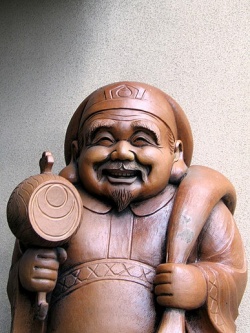Difference between revisions of "Daikoku-ten"
| (2 intermediate revisions by the same user not shown) | |||
| Line 1: | Line 1: | ||
[[File:Daikoku.jpg|thumb|250px|]] | [[File:Daikoku.jpg|thumb|250px|]] | ||
| − | |||
| − | |||
| − | |||
| − | |||
| − | Daikoku's image was featured on the first Japanese bank note, designed by Edoardo Chiossone. | + | |
| + | |||
| + | |||
| + | |||
| + | In [[Japan]], [[Daikokuten]] ([[大黒天]]), the [[god]] of great {{Wiki|darkness}} or blackness, is one of the [[Seven Gods of Fortune]]. [[Daikokuten]] evolved from the [[Hindu]] [[deity]], [[Shiva]]. The [[name]] is the [[Japanese]] {{Wiki|equivalent}} of [[Mahakala]], another [[name]] for [[Shiva]]. | ||
| + | |||
| + | The [[god]] enjoys an [[exalted]] position as a household [[deity]] in [[Japan]]. [[Daikoku's]] association with [[wealth]] and [[prosperity]] precipitated a {{Wiki|custom}} known as [[fuku-nusubi]], or "[[theft of fortune]]". This {{Wiki|custom}} started with the [[belief]] that he who stole [[divine]] figures ([[gods]] and [[goddesses]]) was assured of good [[fortune]], if not caught in the act of [[stealing]]. In the course of [[time]], [[stealing]] [[divine]] images became so common a practice in [[Japan]] that the [[Toshi-no-ichi]] or the "[[year-end-market]]" held in the [[Asakusa Kannon]] [[temple]] became the main venue of the sale and disposal of such images by the fortune-seekers. Many small stalls were opened where articles [[including]] images of [[Daikoku]] were sold on the eve of New Year {{Wiki|celebrations}}. | ||
| + | |||
| + | The [[Japanese]] also maintain the [[symbol]] of [[Mahakala]] as a monogram. The [[traditional]] [[pilgrims]] climbing the {{Wiki|holy}} [[Mount Ontake]] wear [[tenugui]] ([[white Japanese scarves]]) with the [[seed syllable]] of [[Mahakala]]. | ||
| + | |||
| + | [[Daikoku]] is variously considered to be the [[god of wealth]], or of the household, particularly the kitchen. He is [[recognized]] by his wide face, [[smile]], and a flat black hat. He is often portrayed holding a golden mallet called an [[Uchide no kozuchi]], otherwise known as a [[magic]] [[money]] mallet, and is seen seated on bales of {{Wiki|rice}}, with mice nearby (mice signify plentiful [[food]]). | ||
| + | |||
| + | [[Daikoku's]] image was featured on the first [[Japanese]] bank note, designed by Edoardo Chiossone. | ||
{{W}} | {{W}} | ||
[[Category:Buddhist Terms]] | [[Category:Buddhist Terms]] | ||
[[Category:Japanese Buddhism]] | [[Category:Japanese Buddhism]] | ||
[[Category:Mahākāla]] | [[Category:Mahākāla]] | ||
Latest revision as of 00:52, 13 February 2024
In Japan, Daikokuten (大黒天), the god of great darkness or blackness, is one of the Seven Gods of Fortune. Daikokuten evolved from the Hindu deity, Shiva. The name is the Japanese equivalent of Mahakala, another name for Shiva.
The god enjoys an exalted position as a household deity in Japan. Daikoku's association with wealth and prosperity precipitated a custom known as fuku-nusubi, or "theft of fortune". This custom started with the belief that he who stole divine figures (gods and goddesses) was assured of good fortune, if not caught in the act of stealing. In the course of time, stealing divine images became so common a practice in Japan that the Toshi-no-ichi or the "year-end-market" held in the Asakusa Kannon temple became the main venue of the sale and disposal of such images by the fortune-seekers. Many small stalls were opened where articles including images of Daikoku were sold on the eve of New Year celebrations.
The Japanese also maintain the symbol of Mahakala as a monogram. The traditional pilgrims climbing the holy Mount Ontake wear tenugui (white Japanese scarves) with the seed syllable of Mahakala.
Daikoku is variously considered to be the god of wealth, or of the household, particularly the kitchen. He is recognized by his wide face, smile, and a flat black hat. He is often portrayed holding a golden mallet called an Uchide no kozuchi, otherwise known as a magic money mallet, and is seen seated on bales of rice, with mice nearby (mice signify plentiful food).
Daikoku's image was featured on the first Japanese bank note, designed by Edoardo Chiossone.
